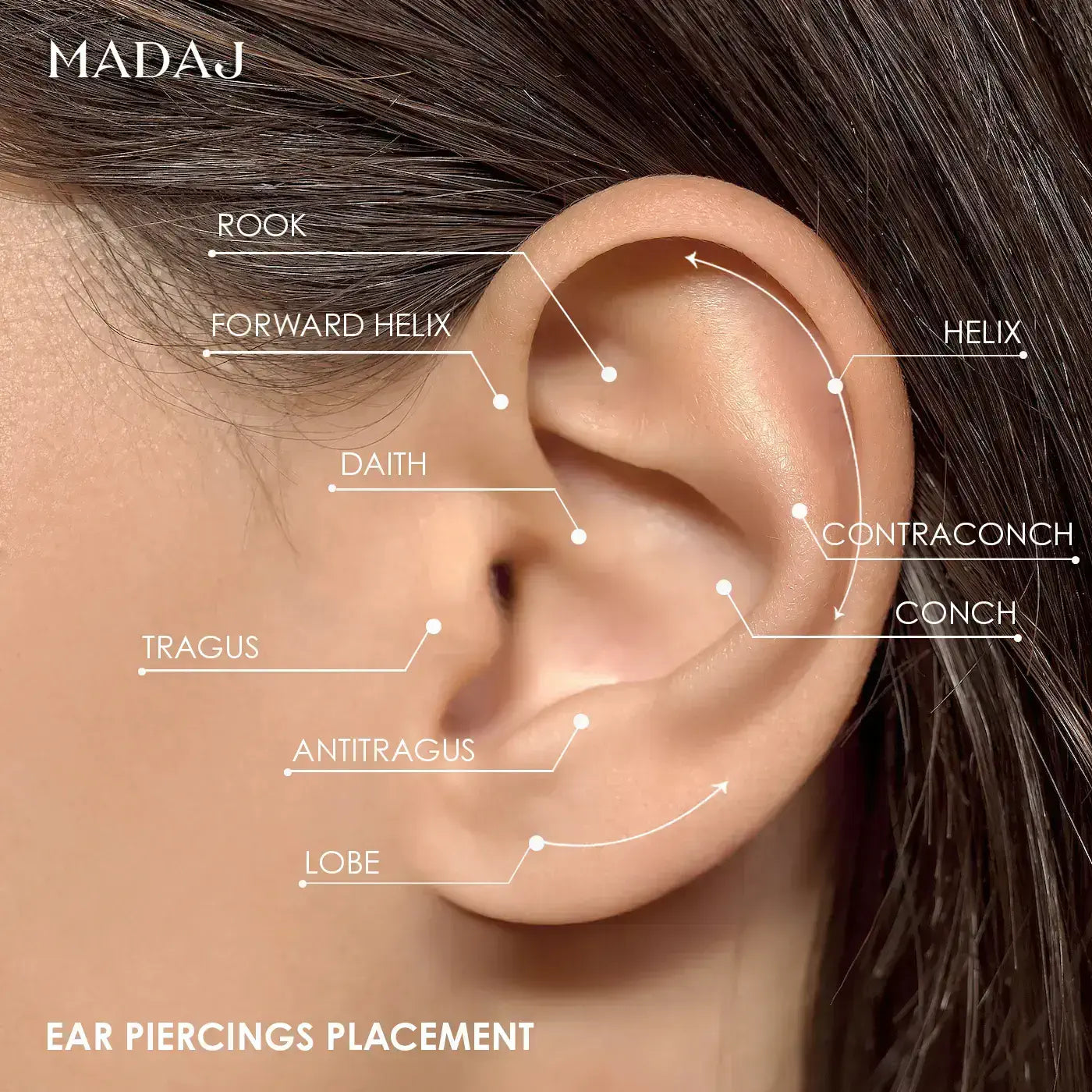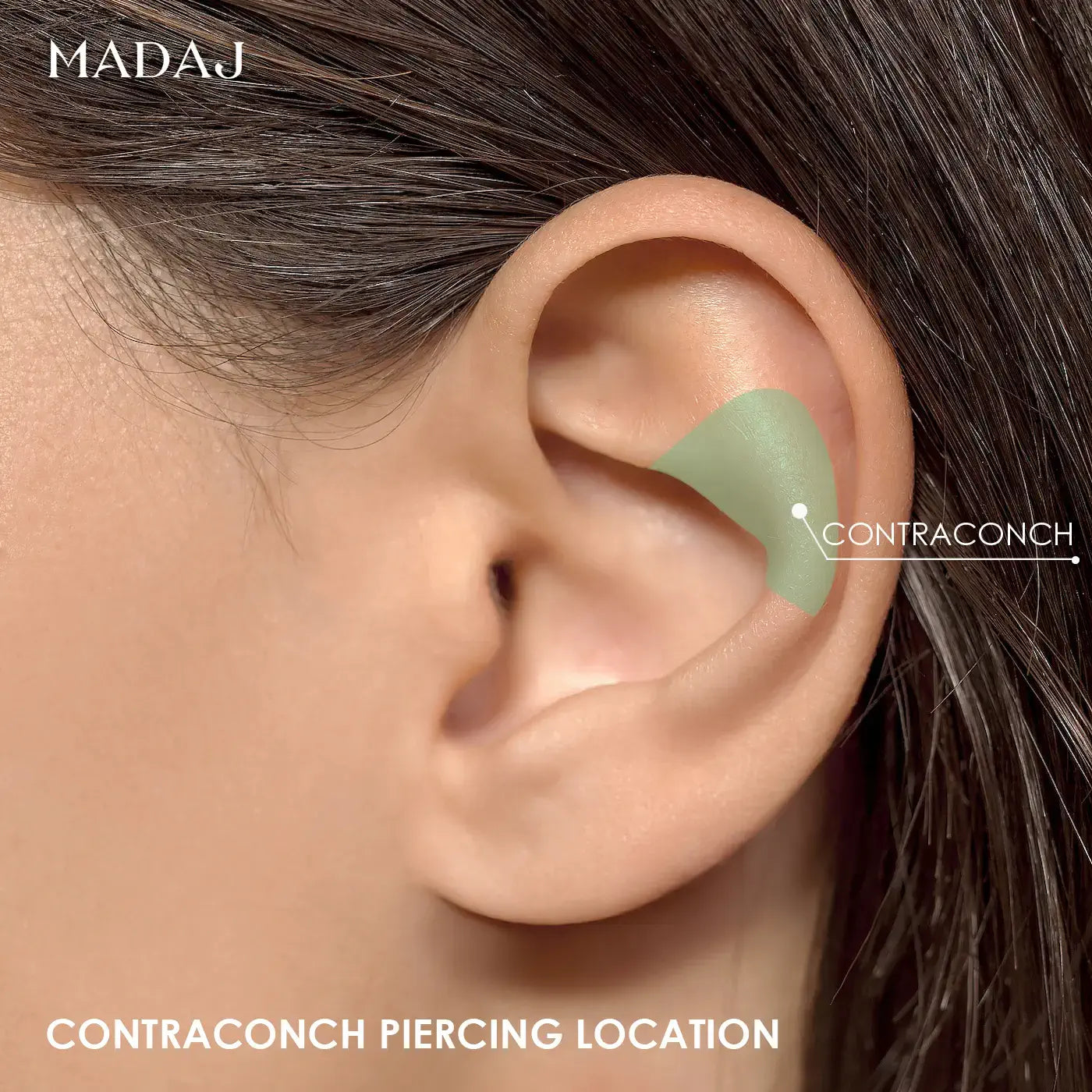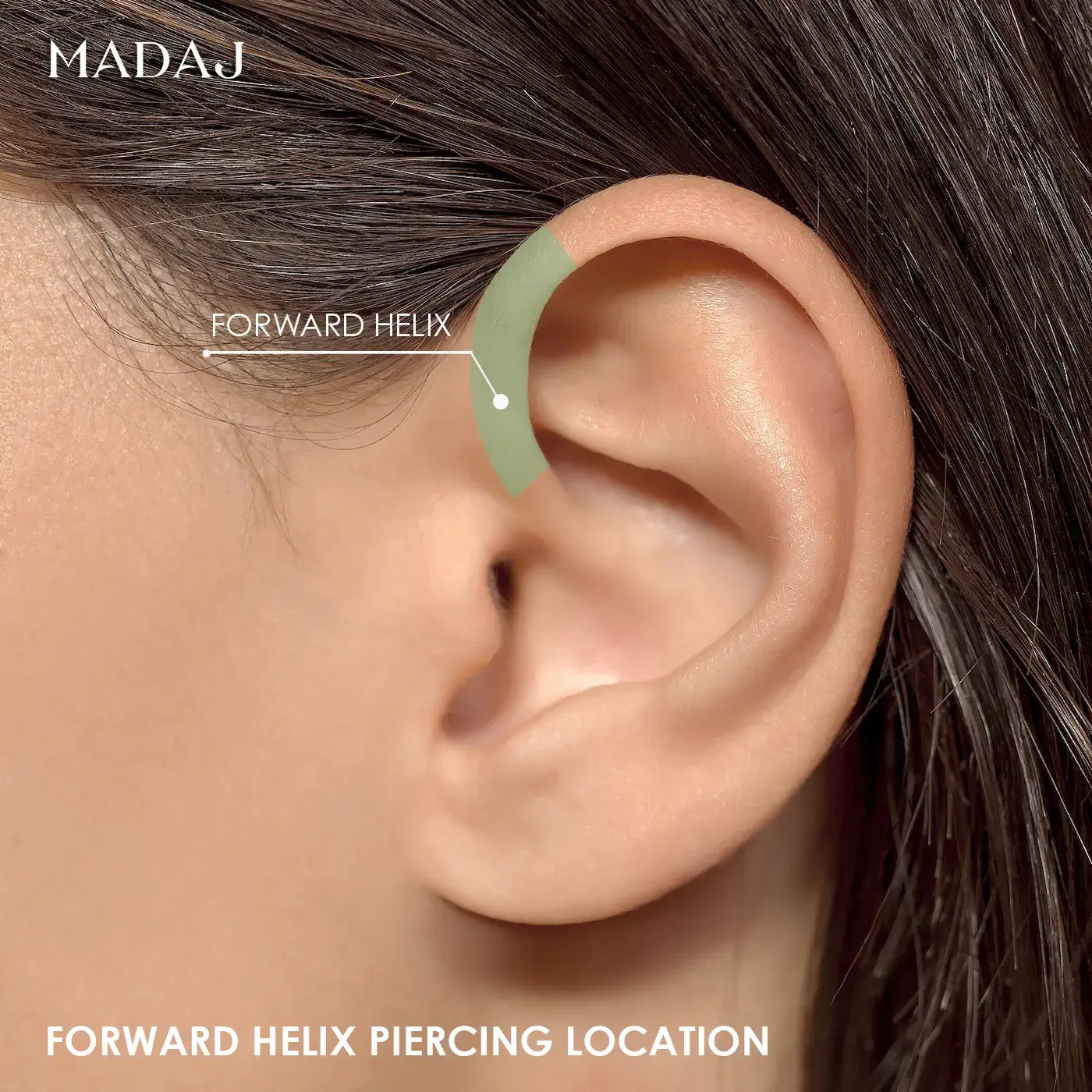Education
EAR PIERCINGS PLACEMENT
Welcome to our comprehensive guide on ear piercing placements.
We’ve gathered all the essential information to help you choose and care for your piercing.
Each section is dedicated to a specific area of the ear, providing details about the piercing name, the characteristics of the area, the estimated healing time, associated pain, and practical tips for daily care.
You’ll also discover suitable diamond piercing options, recommended materials, and ideal sizes for each piercing.
This guide has been designed to give you a complete overview and help you make the best choice for your piercing.

EAR PIERCING LOCATIONS
Each ear piercing has its own characteristics.
In this guide, we will present in detail each area of the ear, the associated types of piercings, their healing time, potential pain, and suitable care tips.
Before starting, take a look at our diagram illustrating the different piercing areas to better understand the options available to you.

ANTITRAGUS PIERCING ZONE
- Location: On the cartilage opposite the tragus, just above the lobe.
- Healing Time: Around 6 to 12 months.
- Pain: Moderate, can be reduced with numbing cream. Mild discomfort may persist during healing.
- Specific Care: Avoid pressure (headphones), clean with saline or gentle antiseptic, don’t touch with dirty hands.
- Recommended Jewelry: Straight bars (with a solitaire or design) and diamond hoops.
- Materials: 18k gold to prevent irritation.
- Jewelry Size: 5mm and 6.5mm for bars, 5mm to 8mm for hoops, depending on anatomy.

CONCH PIERCING ZONE
- Location: In the center of the ear cartilage, in the shell-shaped cavity.
- Healing Time: Around 6 to 12 months.
- Pain: Moderate to high, but generally tolerable. Mild discomfort may persist during healing.
- Specific Care: Avoid pressure (headphones, helmets), clean with saline or gentle antiseptic, and do not touch with dirty hands.
- Recommended Jewelry: Bars or hoops suited to the cavity shape.
- Materials: 18k gold to minimize irritation risks.
- Jewelry Size: 5mm to 6.5mm for bars and 9.5mm to 12.5mm rings, depending on ear anatomy.

CONTRACONCH PIERCING ZONE
- Location: Located on the outer cartilage, just above the conch.
- Healing Time: Around 6 to 12 months.
- Pain: Notable, but generally tolerable. Can be alleviated with a numbing cream. Discomfort may persist during healing.
- Specific Care: Avoid pressure (headphones, helmets), clean with saline or gentle antiseptic, and do not touch with dirty hands.
- Recommended Jewelry: Diamond hoops or bars suited to the cavity shape.
- Materials: 18k gold to minimize irritation risks.
- Jewelry Size: 6.5mm for bars, 8mm to 9.5mm for hoops, depending on ear anatomy.

DAITH PIERCING ZONE
- Location: Located in the upper cartilage of the ear, just above the ear canal.
- Healing Time: Around 2 to 4 months.
- Pain: Moderate. Discomfort may persist during healing.
- Specific Care: Avoid pressure on the area (headphones, earphones), clean with saline or gentle antiseptic, and do not touch the piercing with dirty hands.
- Recommended Jewelry: Hoops suited to the shape of the cartilage.
- Materials: 18k gold to minimize the risk of irritation and allergies.
- Jewelry Size: 6.5mm to 9.5mm diameter for Daith rings, depending on ear anatomy.

FORWARD HELIX PIERCING ZONE
- Location: The anti-helix piercing is positioned on the upper cartilage of the ear, more precisely on the front part of the helix, just above the tragus.
- Healing Time for Anti-Helix Piercing: Around 4 to 6 months.
- Pain during Piercing: Moderate. Mild discomfort may persist during healing.
- Specific Care: Avoid pressure on the area (headphones, glasses), clean with saline solution or gentle antiseptic, and do not touch the piercing with dirty hands.
- Recommended Jewelry for Anti-Helix: Small bars or hoops suited to the shape of the cartilage.
- Recommended Materials: 18k gold to minimize irritation or allergy risks.
- Jewelry Size for Anti-Helix Piercing: 5mm to 6.5mm for bars, 5mm to 6.5mm for hoops, depending on ear anatomy.

HELIX PIERCING ZONE
- Location: The helix piercing is positioned on the upper cartilage of the ear, specifically along the outer rim of the ear.
- Healing Time for Helix Piercing: Around 4 to 6 months.
- Pain during Piercing: Moderate. A slight discomfort may persist during healing.
- Specific Care: Avoid pressure on the area (headphones, glasses), clean with saline solution or gentle antiseptic, and do not touch the piercing with dirty hands.
- Recommended Jewelry for Helix: Small bars, studs, or hoops suitable for the cartilage shape.
- Recommended Materials: 18k gold to minimize irritation or allergy risks.
- Jewelry Size for Helix Piercing: 5mm to 6.5mm for bars, 6.5mm to 8mm for hoops, depending on ear anatomy.

LOBE PIERCING ZONE
- Location: The lobe piercing is located on the lower part of the ear, in the soft and fleshy area of the lobe.
- Healing Time for Lobe Piercing: Around 2 to 4 months.
- Pain During Piercing: Light to moderate. The lobe is a relatively low-pain area to pierce.
- Specific Care: Clean regularly with saline solution or a mild antiseptic. Avoid touching the piercing with dirty hands and avoid tight clothing that could rub against the piercing.
- Recommended Jewelry for Lobe: Studs, hoops, or small bars suitable for the size of the lobe.
- Recommended Materials: 18k gold to prevent irritation and promote healing.
- Jewelry Size for Lobe Piercing: 5mm to 6.5mm for studs, 6.5mm to 9.5mm for hoops, depending on the anatomy of the lobe.

ROOK PIERCING ZONE
- Location: The rook piercing is located in the upper part of the ear cartilage, just above the tragus, in the inner "C"-shaped area of the cartilage.
- Healing Time for Rook Piercing: Approximately 6 to 12 months.
- Pain During Piercing: Moderate to high, as this area is quite dense. Mild discomfort may persist during healing.
- Care for Rook Piercing: Avoid any pressure on the area (headphones, helmets), clean with a saline solution or a mild antiseptic, and do not touch the piercing with unwashed hands.
- Recommended Jewelry for Rook Piercing: Curved bars or hoops suitable for the shape of the cartilage.
- Recommended Materials: 18k gold to avoid irritation or allergies.
- Jewelry Size for Rook Piercing: 5mm to 6.5mm for curved bars, and 5mm to 6.5mm for hoops, depending on ear anatomy.

TRAGUS PIERCING ZONE
- Location: The tragus piercing is located on the small piece of cartilage that partially covers the ear canal, situated just in front of the ear canal entrance.
- Healing Time for Tragus Piercing: Approximately 4 to 6 months.
- Pain During Piercing: Moderate, as the tragus has a dense structure. Mild discomfort may persist during the healing process.
- Care for Tragus Piercing: Avoid any pressure on the area (headphones, helmets), clean with a saline solution or a mild antiseptic, and do not touch the piercing with unwashed hands.
- Recommended Jewelry for Tragus Piercing: Small studs, or hoops designed to fit the contour of the tragus.
- Recommended Materials: 18k gold to minimize irritation and allergies.
- Jewelry Size for Tragus Piercing: 5mm to 6,5mm for barbells and 5mm to 6.5mm for hoops, depending on the ear anatomy.
Ear piercings
FAQ
General Information
Adults can get their ears pierced at any age as long as they are in good health. For minors, parental consent is required, and the minimum age may vary depending on local laws. It’s important to consult with a professional piercer before undergoing any procedure.
Ear piercings can generally be done for children from the age of 7, provided there are no medical contraindications. Parental consent is mandatory, and the child should be ready to care for their piercing.
Yes, it’s possible to get multiple ear piercings during the same session. However, this depends on your pain tolerance and your ear's ability to heal properly. It is recommended to consult with a professional piercer to assess if it’s a suitable option.
Yes, it’s possible to get both ears pierced at the same time. Many professional piercers offer this option, but it’s essential to ensure that the procedure is done under optimal hygienic conditions. Your piercer will guide you based on your personal situation.
Yes, it’s possible to get your ear pierced again if the hole has closed, but this depends on how long it’s been since it closed and the location of the piercing. Your piercer will assess the situation before proceeding. In some cases, it may be necessary to wait before attempting a new piercing.
Piercing Aftercare and Maintenance
To clean your piercing, use a sterile saline solution or a gentle antiseptic. Apply it gently with a cotton swab or clean compress, avoiding friction. Clean it twice a day until the piercing is fully healed.
Yes, you can wash your hair after getting an ear piercing, but it’s important to protect your piercing from chemicals and avoid rubbing or pulling on the jewelry. Use a mild shampoo and avoid products with fragrances or irritating ingredients.
To avoid infections, choose hypoallergenic materials such as 18-carat gold. This metal is biocompatible and resistant to bacteria, reducing the risk of infection.
Symptoms of an allergy to a piercing include itching, redness, swelling, or rashes around the jewelry. If you experience these signs, consult a professional to adjust the jewelry, and switch to hypoallergenic material such as 18k gold.
Complications and Symptoms
Signs of infection include persistent redness, swelling, pain, heat, and pus discharge. If you notice these symptoms, it’s important to consult a healthcare professional for appropriate treatment.
Infections are characterized by increased pain, redness, swelling, yellow or green discharge, and warmth around the piercing. If you notice these signs, consult a doctor immediately. Do not remove the jewelry before consulting a specialist to avoid trapping the infection inside.
Piercing and Daily Activities
It’s not recommended to swim in non-sterile water, such as public pools, lakes, or the ocean, during the healing period of your piercing. These environments can expose your piercing to bacteria and increase the risk of infection. Wait until your piercing is fully healed before swimming in these types of water.
Yes, it is possible to get an ear piercing in the summer, but it’s important to take precautions. Heat and sun exposure can slow down the healing process. Protect your piercing from the sun, and avoid situations where it could be exposed to bacteria, such as in pools or the ocean.
